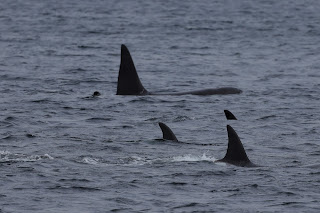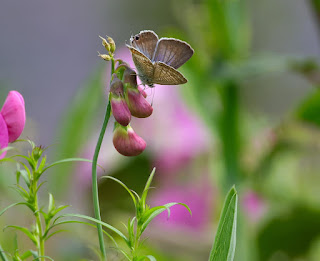Embarking on a wildlife adventure in Shetland during late October might not be the most opportune time to spot Orcas, as these magnificent creatures are typically more abundant during spring or late November. My prior trip to the island two years ago left me disheartened, with just one distant sighting up north, and by the time we arrived, the pod had moved on. With three consecutive weeks of zero sightings, our hopes were quite low.
To our surprise, fate smiled upon us when we received a text on our first morning, informing us of a pod heading south near one of the headlands. Consulting the map, we quickly moved further south to intercept them. Our familiarity with the terrain proved invaluable, and the sight of the pod, led by an impressive bull, rounding the headland into Cunningsburgh was awe-inspiring. Observing these majestic marine mammals from a vantage point approximately 500 meters above was nothing short of breathtaking.
Continuing our journey southward to Sandsayre Pier, I anticipated a close encounter as the area was populated with seals, the primary prey of Orcas. Standing at ground level, we were treated to a mesmerizing spectacle. Following them around the headland, I witnessed the bull switch into hunting mode and skillfully capture a seal right before my eyes. The sudden change in pace was both astonishing and terrifying, leaving the seal with no chance of escape.
Our luck held as we encountered the Orcas once more at Grutness before they gracefully maneuvered around Sumburgh Head. This experience was truly beyond words, a genuine addition to my wildlife bucket list.
I've had lots of questions since my return so I've pasted in Hugh Harrop's FAQ's from his helpful Facebook group. Hugh manages wildlife tours and is worth contacting id you are looking to join a tour.
SHETLAND ORCA FAQ'S
1. When is the best time to see Orca in Shetland?
Orca can be seen in all months of the year but can be highly variable. Generally there are peaks in June - July, October - December and March. See below for chart of days present each month over the last couple of years but note the picture is an evolving one! There is no time of day that is better – they can, and do, turn up at all hours!.
2. Where are they now? Any updates?? How to turn on notifications from this sightings page...
Updates will be posted as soon as they can be. Please note that there may be patchy signal in the field and updates might not always be as instant. To receive updates / further notifications on a particular thread go to the three dots top right of post and then select ‘turn on notifications’. For notifications to new posts to the page itself, click on the ‘bell icon’ on the top right of the page and then set your ‘in app’ notifications to ‘select all posts’.
3. Where is the best place to go?
Orca have been spotted all around the coast of Shetland. Some places are easier to get to than others. Tip – try to get ahead of their direction of travel as they rarely change direction once on a particular trajectory.
4. What does the ‘64s pod’ mean?
Pods are named after the number of the assumed matriarch. Every Scottish Orca that we have photographed to a standard that allows it to be identifiable has been assigned a unique number. So #64 is the assumed matriarch of the '64s' and #27 is the assumed matriarch of the '27s'. These pods and their members are detailed in the latest Scottish Orca Catalogue which we released in May 2021 - download at https://bit.ly/2QQ6oOJ 5. Are there any boat trips to see Orcas?
There are NO specific Shetland-based boat trips to see Orca or other cetaceans. The vast majority of Orca sightings are from land and as you can see from this group, amazing photos and videos are achieved. Viewing from land guarantees that there is no disturbance to cetaceans. You may however be lucky to spot Orca during a wildlife trip to one of the islands, on a sea-angling trip or even from the inter-island ferries.
6. So, I’m on Shetland for X days how do I maximise my chances of seeing them?
There are no guarantees – but to maximise your chances try to have as many days here as you can. Be flexible and make sure you have your own transport. There is a lot of other amazing wildlife to be seen. Sometimes just picking one spot and watching can be as productive as driving around everywhere – remember someone has to spot them first – why not you?!
7. Where is X location? How do I get to X?
Invest in a good mapping app and familiarise yourself with some of the coastal names before you visit. Google maps isn’t always the greatest at presenting small rural place names but if you search for it in the search box it will show you the location. Beware that there are many duplicates of place names (particularly skerries and headlands) – sightings should have the wider area attached to try and make that clear eg. Aith Voe Cunningsburgh as opposed to Aith Voe, West Mainland or check the area where they were last seen – the next sighting is very likely to be in the same general vicinity. If all that fails please ask - but bear in mind you may not get an answer immediately as folk are either out in the field, travelling or even stuck at work trying to update and pass on sightings when they can!
8. What are they feeding on?
The three Northern Isles community pods that we see inshore (and most regularly encountered) are top predators that feed predominantly on seals and porpoise with otters and seabirds also occasionally targeted. They do not – as far as we aware - target fish. Occasionally in the winter we may see large pods of the offshore animals, normally around the pelagic fishing boats, predating herring and mackerel.
9. Is that a new calf? I thought they were dying out…
The Northern Isles Community appears to be a healthy population with a number of new calves recorded each year. You will not find some of them in the photo ID catalogue as we normally wait until the calf is at least one year old before adding it.
10. Are there any rules about watching Orca and other wildlife?
Yes. We request that at all times you follow the Scottish Marine Watching Wildlife Watching Code. It can be downloaded at https://tinyurl.com/36mjacry Oh – and don’t forget to also follow the Scottish Outdoor access Code at all times - https://orlo.uk/TcpEn 11. I read somewhere that Shetland Orcas all come from Iceland. Is this true?
Not exactly! Intensive citizen science photo ID work over the last decade has identified several pods of Orcas in Scottish waters that have also been recorded in Iceland. A pattern is certainly emerging of approx. 30 animals spending the winter months in Iceland and travelling to Scottish waters for some of the summer. And one of our Northern Isles Community pods has also been recorded in Icelandic waters, too. It is early days to be able to draw firm conclusions…

























